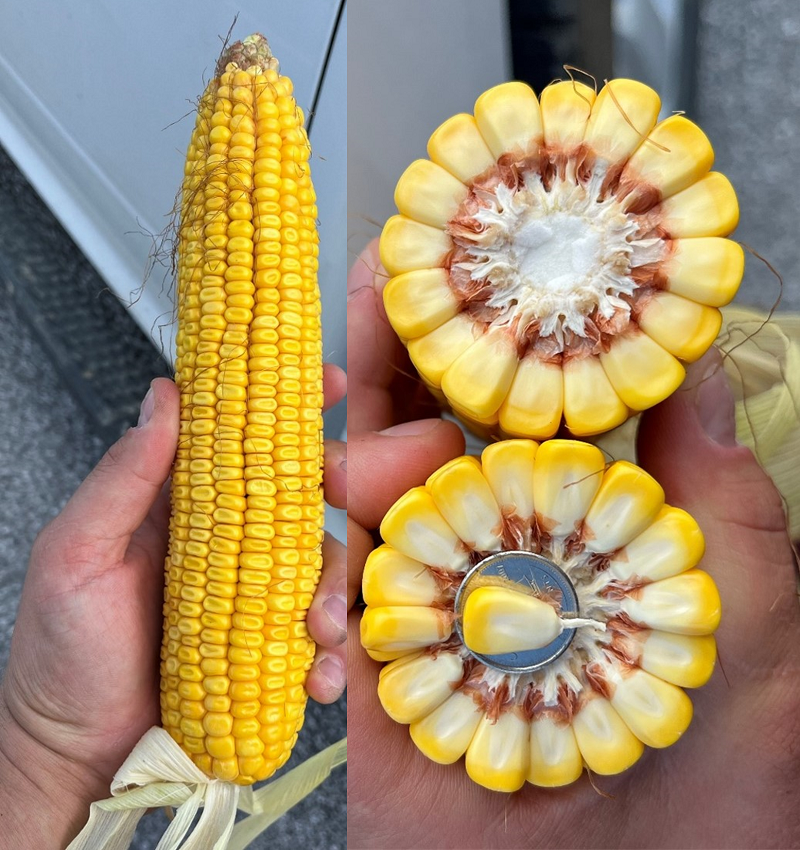Kernel Mass vs. Kernel Number Explained
August 1, 2023At Maizex, our agronomy team has spent the last few years classifying hybrids by kernel numbers or kernel mass. This provides insight into how the hybrids build yield and ultimately helps growers make better hybrid placement decisions. Our work has demonstrated that most hybrids can be categorized as either ‘kernel number hybrids’ or ‘kernel mass hybrids.’
Kernel number hybrids rely on their inherent ability to generate a high volume of kernels. Kernel number is determined earlier in the season than kernel mass. Kernel number is a combination of how many kernels long an ear is and how many kernel rows round. Kernel rows round, or girth, is determined at V4–V8 while kernels per row is determined starting between V5 and V7 and ending between V12 and V15 depending on the hybrid. Length is impacted at pollination. A hybrid may set 40 kernels per row but only pollinate 30 or, conversely, only set 32 kernels per row and pollinate all 32.
The combination of a high number of rows round and kernels per row results in a high kernel count per ear. These hybrids tend to flex more in girth and length than they do in kernel weight. It is important to understand that flex does not mean flexing up—it means flexing down. Flex is a measure of how likely a hybrid is to give up girth or length, not add to it, based on the plant’s read of environmental conditions. The same is true for kernel mass flex; a hybrid with high kernel mass flex could fill a very large, massive kernel, but it also carries the risk that the kernels don’t fill out to their genetic potential and thus flex down.


Kernel mass hybrids can still be influenced by the early-season environment, pollination, and general management, but they have a higher percentage of their yield built late in the season. These hybrids rely on the grain-fill of a larger kernel to increase the total yield. Without heavy kernels, these hybrids will back off their top-end yield potential. Conversely, kernel number hybrids rely on large ears with high kernel numbers to maximize yield potential.
In some years, a kernel mass hybrid may not possess genetics with high enough kernel count to beat a kernel number hybrid given conditions at grain-fill. In other years, with seasons where early ear development was inhibited by weather, hybrids that relied on kernel number to win may not have the genetics behind them to build massive enough kernels to compete against a hybrid with a strong kernel flex.
Some management decisions may be influenced by how a hybrid builds its yield. For example, a kernel number hybrid may need to be planted into fit, warm soil more than a kernel mass hybrid does because so much of its yield potential is determined by its rows round. A hybrid with the potential to reach 24 rows round is often seen with only 16 or 18 rows round if conditions don’t allow for that girthy ear. Kernel mass hybrids often have fewer rows round and are less prone to losing those rows. They may range from 14–18 rows round depending on hybrid, but only lose 2 rows in adverse conditions instead of 4 or 6.
Early nitrogen is important no matter when the hybrid builds its yield, but a strong starter program may have a bigger impact on yield for a kernel number hybrid than for a kernel mass hybrid. Kernel number hybrids with a strong disease package and stay-green seem less responsive to fungicides than kernel mass hybrids, where late-season fungicides are crucial to increase the grain-fill window and thus increase the mass of those kernels.
It is still important, no matter the hybrid, to evaluate the plant health, disease pressure, risk, and historical response to a fungicide application. However, in many cases in Southwestern Ontario given the disease spectrum encountered, fungicide applications on most corn hybrids are a profitable decision year in and year out.
Kernel mass hybrids may also benefit from later season split nitrogen to keep the plant healthy and green. This increases the ability to move sugars from the plant to the kernels to maximize its yield potential.
For more insight into this topic, both our 2022 and 2023 agronomy summaries have articles that further discuss our research efforts into kernel mass and kernel number.
Henry Prinzen, CCA-ON
Market Development Agronomist
